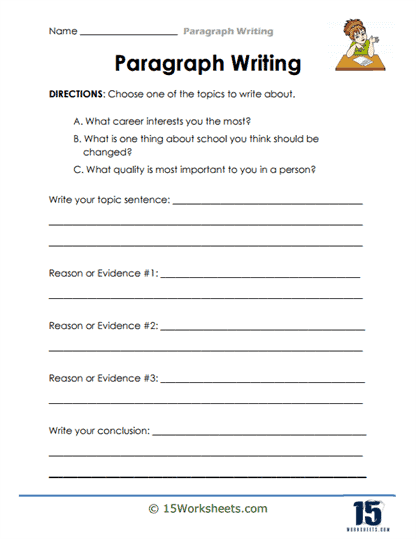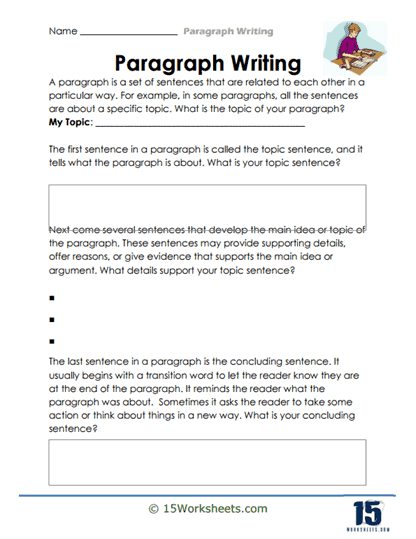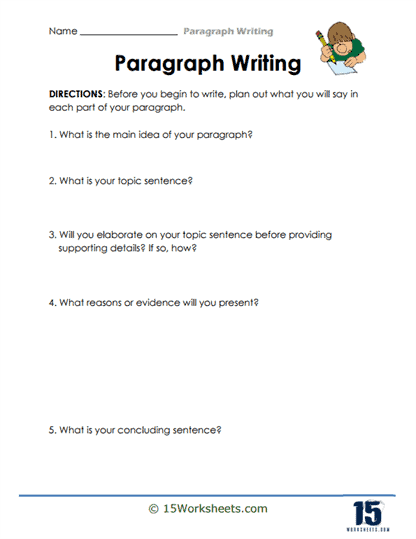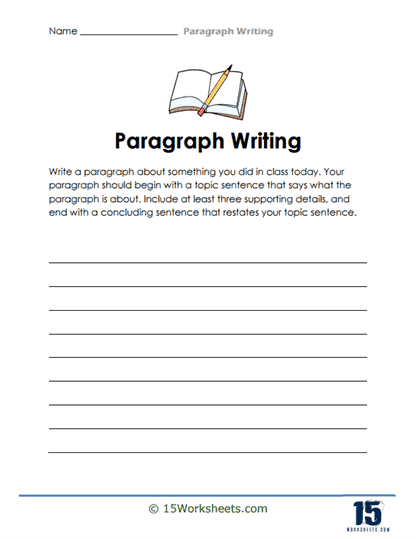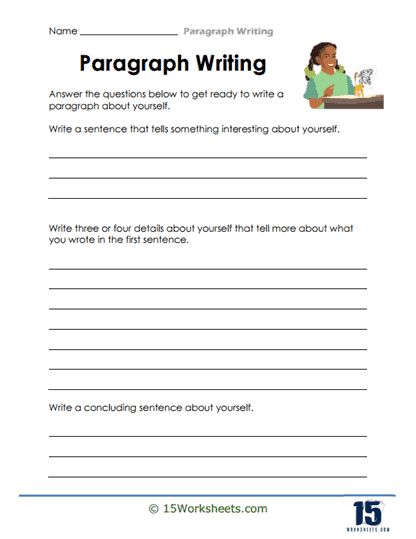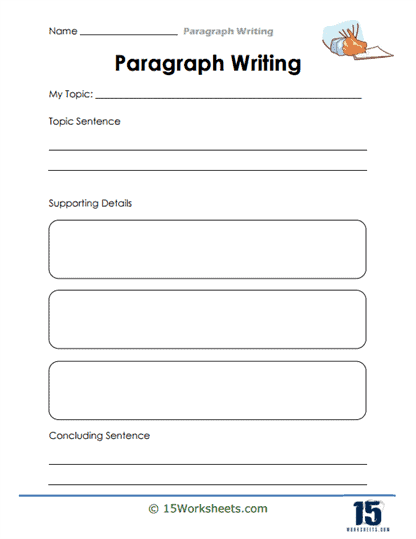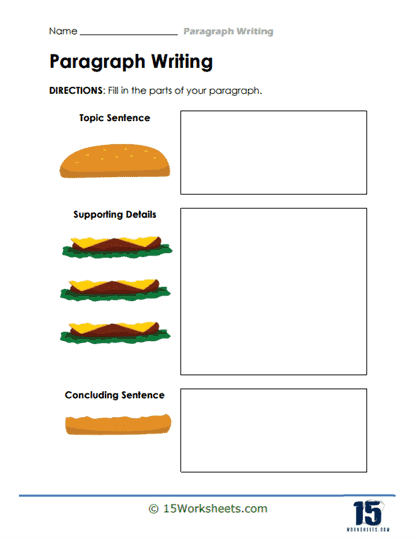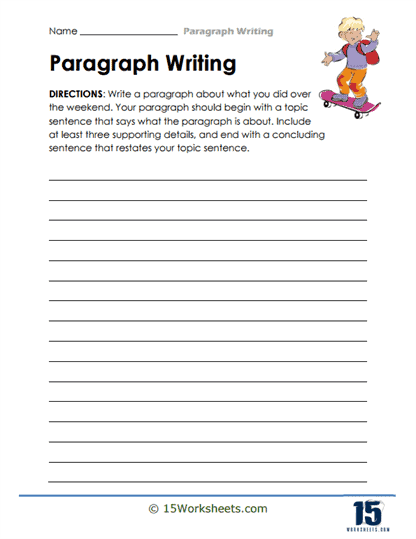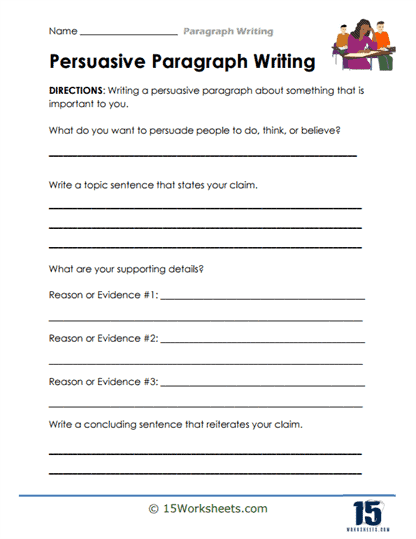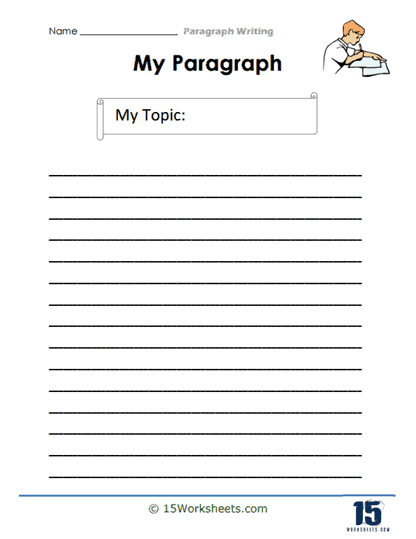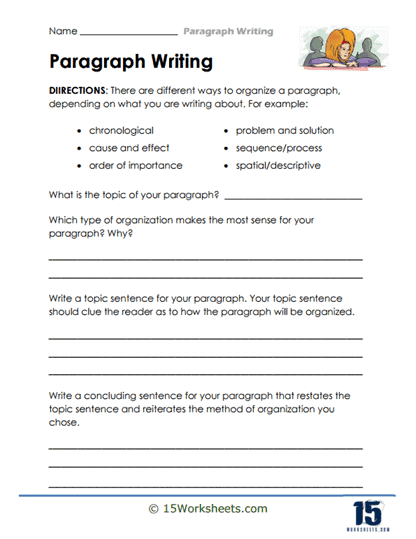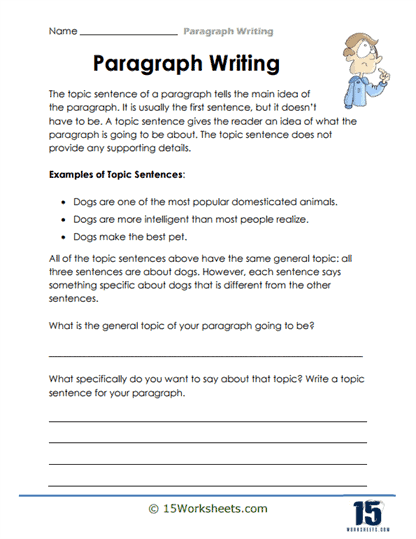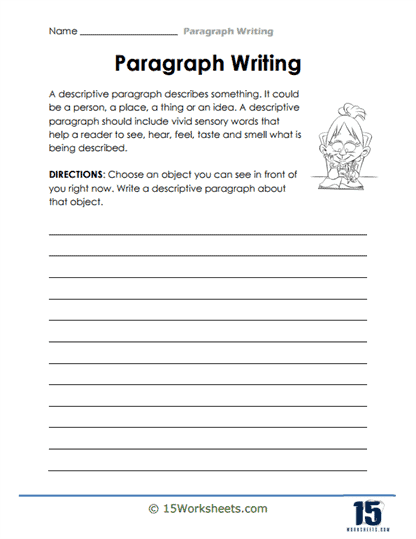Paragraph Writing Worksheets
All About These 15 Worksheets
The collection of paragraph writing worksheets provided offers a comprehensive approach to teaching students how to construct well-formed paragraphs. Each worksheet emphasizes different aspects of paragraph structure, guiding students step by step through the process. Below is a detailed description of the skills these worksheets aim to develop:
1. Understanding Paragraph Structure
The worksheets focus on teaching students the basic components of a paragraph – the topic sentence, supporting details, and the concluding sentence. This foundational structure is emphasized repeatedly across the worksheets, ensuring students grasp the necessity of beginning with a clear topic sentence that introduces the main idea, followed by supporting details that elaborate on this idea, and ending with a concluding sentence that reinforces the main point.
2. Developing Topic Sentences
Multiple worksheets ask students to come up with a strong topic sentence, an essential skill for any writer. By prompting students to think about the main idea they want to convey, these exercises help them practice clarity and focus, encouraging them to establish the purpose of their writing right from the beginning.
3. Supporting Details and Elaboration
Several worksheets include sections dedicated to the development of supporting details, which ask students to think critically about how to substantiate their topic sentences. These activities promote logical thinking, encouraging students to back up their main idea with reasons, evidence, or examples. They also introduce the concept of a well-developed paragraph with enough detail to make the central idea compelling.
4. Concluding Sentences
The inclusion of the concluding sentence across worksheets highlights the importance of summarizing and reiterating the main idea. This practice is crucial in helping students learn how to end their paragraphs effectively and remind the reader of the paragraph’s central message.
5. Variety of Paragraph Types
The worksheets reflect a variety of writing purposes, including:
Descriptive Paragraphs – One worksheet asks students to describe an object, helping them develop sensory writing skills and use vivid language.
Persuasive Writing – Another worksheet focuses on persuasive paragraph writing, guiding students to make a claim, present evidence, and conclude by reiterating their stance.
Personal Writing – Some worksheets prompt students to write about personal experiences, such as what they did over the weekend or something interesting about themselves. This helps in developing narrative writing skills and self-expression.
6. Pre-Writing and Organization
A few worksheets include graphic organizers, such as one modeled after a sandwich, to help students visually plan out their paragraphs. These tools reinforce the importance of planning and organizing ideas before beginning to write, making the process of paragraph writing more manageable for younger or less experienced students.
One worksheet emphasizes different methods of paragraph organization, such as chronological order, cause and effect, or problem and solution, encouraging students to think about the best way to organize their ideas based on the purpose of the paragraph. This reinforces the concept of writing with intention, where the structure is adapted to suit the topic and purpose.
7. Promoting Critical Thinking
The process of writing detailed paragraphs involves critical thinking. Whether students are defending an opinion in a persuasive paragraph or describing something using sensory details, they are being asked to think deeply about their subject and how to convey it effectively to the reader.
Several worksheets provide blank spaces for students to write their paragraphs after completing the planning exercises. These sheets allow for practical application of the skills they’ve been working on, from creating coherent topic sentences to adding supporting details and concluding effectively.
What Are the 5 Rules of a Paragraph Writing?
When it comes to effective paragraph writing, a few core principles can dramatically shape the clarity and impact of your communication. Although different contexts and styles may call for slight variations, there are five universally recognized rules that every writer should follow to create well-structured, compelling paragraphs. These rules-unity, coherence, order, completeness, and conciseness-form the foundation of good writing, whether you’re crafting a short story, an essay, or even a business report. By understanding and applying these rules, you can ensure that each paragraph serves its purpose, delivers its message with precision, and smoothly integrates into the larger work.
Rule 1: Unity – Stay Focused on a Single Idea
At the heart of every well-written paragraph lies a single, focused idea. This concept, known as unity, means that all the sentences in a paragraph should revolve around one central theme or argument. Each sentence you write should contribute to that theme, supporting, explaining, or expanding upon the main point. The moment a sentence deviates from this core idea, the paragraph starts to lose its impact, leaving the reader confused or disoriented. A good way to achieve unity is by crafting a strong topic sentence-a sentence that clearly defines the main idea you’re about to explore. This topic sentence sets the tone for everything that follows, serving as a guidepost for both the writer and the reader. For example, if your paragraph is about the benefits of exercise, every sentence should reinforce that idea, whether by providing examples, evidence, or further elaboration. If you find yourself veering off into unrelated territory, like discussing diet instead of exercise, it’s a sign that the paragraph lacks unity. Unity creates focus, and focus ensures that your reader absorbs the key message you’re trying to convey.
Rule 2: Coherence – Ensure Logical Flow and Connection
A paragraph is not just a collection of sentences; it’s a series of thoughts that are intricately linked to form a coherent whole. Coherence refers to the logical flow from one idea to the next, where each sentence builds on the previous one in a natural progression. This is achieved through the use of transitions, whether explicit (like using words such as “furthermore,” “in addition,” or “on the other hand”) or implicit, by ensuring that each sentence logically follows from its predecessor. Without coherence, your reader may struggle to understand how the ideas fit together, leaving them disoriented. Coherence allows the reader to move through your argument or explanation smoothly, making your writing much more engaging and persuasive. Think of it like a river, where the water flows seamlessly from one bend to the next-each turn in the river is part of the whole journey, and none of it feels disjointed. Achieving coherence means that your reader will never feel lost or wonder how one idea connects to the next. Instead, they’ll be carried through the paragraph with ease, following your logic naturally.
Rule 3: Order – Organize Ideas for Maximum Impact
Organization is key when structuring a paragraph. This rule, often referred to as “order,” ensures that your information is presented in a sequence that makes sense to the reader. Typically, this involves a beginning, middle, and end-a structure that has proven effective in almost every form of communication. The beginning introduces the topic or main idea, the middle provides the necessary details, explanations, or evidence, and the end wraps up the paragraph, either by summarizing the point or transitioning to the next idea. However, the specific order can vary depending on the purpose of the paragraph. For example, if you’re writing a narrative, you might present events chronologically, while an argumentative paragraph might prioritize points based on their strength. In either case, order is what gives your paragraph clarity and purpose. Without a clear structure, even the most brilliant ideas can become muddled, making it difficult for readers to follow your train of thought. When the information is logically ordered, your reader can easily grasp the significance of each point, and the overall message becomes much more compelling.
Rule 4: Completeness – Develop Your Ideas Fully
Completeness is a rule that speaks to the depth of your writing. A paragraph should provide enough detail to fully develop its main idea, leaving no essential questions unanswered. In practice, this typically means writing at least three to five sentences, depending on the complexity of the idea. The first sentence often introduces the topic, while subsequent sentences offer support in the form of evidence, examples, or further explanation. The final sentence should either conclude the paragraph or serve as a transition to the next one. A well-rounded paragraph not only makes its point but also supports that point adequately, giving the reader enough information to understand why the point matters. However, completeness doesn’t mean overloading the reader with unnecessary details; instead, it’s about providing just enough to make your argument convincing or your explanation clear. A paragraph that is incomplete leaves readers with lingering questions or a sense of dissatisfaction, while a complete paragraph leaves them feeling informed and prepared to move on to the next idea.
Rule 5: Conciseness – Say Enough, But No More
While it’s important to fully develop your ideas, it’s equally important not to overdo it. Conciseness is the art of saying exactly what you need to say-no more, no less. Every word in a paragraph should serve a purpose, and every sentence should contribute something valuable to the overall point. If you find yourself repeating the same idea in multiple sentences or adding unnecessary information, the paragraph becomes bloated and less effective. In contrast, concise writing is sharp and to the point, making your argument more powerful and easier to understand. Striking the right balance between completeness and conciseness can be challenging, but it’s essential for clear communication. Think of your paragraph as a piece of fine sculpture: you start with a block of raw material (your ideas), and through careful refinement, you chip away at unnecessary parts until only the essential structure remains. By keeping your writing concise, you respect the reader’s time and attention, ensuring that each sentence adds value to the overall message.
How Do you Start Writing a Paragraph?
Starting to write a paragraph can feel daunting at first, but the process becomes much easier once you break it down into manageable steps. The goal of any paragraph is to express a single main idea clearly and effectively. Whether you’re drafting an essay, a report, or even a blog post, a strong paragraph builds the foundation of your writing, guiding your reader through your thoughts and arguments. To ensure that your paragraph fulfills its purpose, it’s important to follow a structured approach. Let’s dive into the steps that will help you craft a well-developed, engaging paragraph from start to finish.
Step 1: Identify the Main Idea – Clarify Your Focus
Before you even start writing, you need to be clear about the main idea you want to convey. This step is crucial because it serves as the anchor for everything that will follow in your paragraph. The main idea is the central thought or point you want to get across, and identifying it before you write ensures that all your sentences stay focused and relevant. Ask yourself: What is the primary message I want the reader to understand? Whether it’s a personal insight, a factual statement, or an argument you want to make, being precise about your main idea will help streamline the writing process. This clarity prevents you from straying off-topic and helps guide your writing in a purposeful direction. Think of it like plotting a course before setting sail-knowing where you’re headed helps you avoid drifting aimlessly.
Step 2: Write a Topic Sentence – Make a Strong First Impression
Once you’ve settled on your main idea, it’s time to craft a topic sentence. This sentence is typically the first sentence of your paragraph, and its purpose is to introduce the main idea clearly and concisely. The topic sentence acts as a roadmap for your reader, giving them a clear indication of what to expect in the following sentences. A well-written topic sentence is not just informative-it grabs the reader’s attention and sparks their interest in the paragraph. For instance, if you’re writing about the benefits of exercise, a strong topic sentence might be, “Regular physical activity is one of the most effective ways to improve both mental and physical health.” This sentence immediately informs the reader of the subject and hints at the specific benefits you’ll explore in the body of the paragraph. The topic sentence sets the tone, and a compelling one can make the reader eager to continue.
Step 3: Brainstorm Supporting Ideas – Build a Solid Foundation
After crafting a clear and engaging topic sentence, the next step is to brainstorm supporting ideas that will flesh out your paragraph. These ideas should directly relate to your main point and serve to explain, elaborate, or provide evidence for your topic sentence. Take a moment to think about different angles from which you can approach your main idea. What facts, examples, or arguments can you provide to reinforce your point? For instance, if your paragraph is about how exercise boosts mental health, you might brainstorm ideas such as improved mood, reduced anxiety, and better sleep as key supporting points. Each of these ideas will form the basis for the body of your paragraph, ensuring that you offer a well-rounded and fully developed argument. This brainstorming phase not only helps generate content but also ensures that your paragraph will be complete and substantial.
Step 4: Organize Your Key Points – Create a Logical Flow
With your supporting ideas in hand, the next step is to organize them in a way that makes sense. This step is about creating order-deciding the best sequence to present your points so that they build on one another logically. Usually, this means starting with your most important or strongest point and then following with additional details or examples that reinforce it. Alternatively, you might present your points chronologically, or in a cause-and-effect structure, depending on the nature of your paragraph. Good organization ensures that your ideas are easy for the reader to follow and that your argument develops in a clear and cohesive manner. If, for example, you’re writing about the mental health benefits of exercise, you might start with the most immediate and obvious benefit-improved mood-before moving on to longer-term effects like reduced anxiety and better sleep. Organizing your points thoughtfully can turn a series of disconnected thoughts into a compelling narrative or argument.
Step 5: Write the Body of the Paragraph – Expand on Your Ideas
Once your points are organized, it’s time to write the body of the paragraph. Here, you’ll expand on the supporting ideas you brainstormed earlier, turning them into fully developed sentences. Each sentence should contribute to explaining or supporting the main idea introduced in the topic sentence. This is where you’ll offer examples, evidence, or explanations to back up your points. For example, if one of your supporting ideas is that exercise improves mood, you might write a sentence like, “Studies have shown that physical activity releases endorphins, which are known to enhance mood and reduce feelings of stress.” Follow that up with additional sentences that further explain or provide examples of how this benefit plays out in real life. It’s important that each sentence flows smoothly into the next, creating a seamless reading experience. To maintain coherence, use transitional words or phrases such as “in addition,” “furthermore,” or “as a result,” which help connect ideas and guide the reader through your paragraph.
Step 6: Write a Concluding Sentence – Bring Closure
After you’ve written the body of the paragraph, you’ll want to end with a concluding sentence. The concluding sentence serves to wrap up the paragraph by reinforcing the main idea and providing a sense of closure. It often echoes the topic sentence in some way, restating the central point in a different manner or summarizing the key takeaways. For example, a concluding sentence for a paragraph about the mental health benefits of exercise might be, “In short, regular exercise is a simple yet powerful tool for boosting mental well-being.” If you’re writing a longer piece, the concluding sentence can also serve as a transition to the next paragraph, helping to maintain the flow of your writing. While this sentence should be concise, it’s crucial for ensuring that the reader leaves the paragraph with a clear understanding of its purpose and content.
Step 7: Review and Revise – Refine for Clarity and Impact
Once you’ve completed your paragraph, the final and arguably most important step is to review and revise your work. Writing is a process, and your first draft is rarely perfect. Take a moment to reread the paragraph with a critical eye, asking yourself questions like: Does the paragraph communicate the main idea effectively? Do all the sentences contribute to the central theme? Is there a logical flow from one sentence to the next? Revising allows you to catch any issues with clarity, coherence, or organization that might not have been obvious during the initial writing. You might find that some sentences need rephrasing for better clarity, or that certain details are unnecessary and can be removed for conciseness. Don’t be afraid to make substantial edits-good writing is often the result of thoughtful revision. Ultimately, this step ensures that your paragraph is polished, clear, and engaging, ready to make the best possible impression on your reader.



